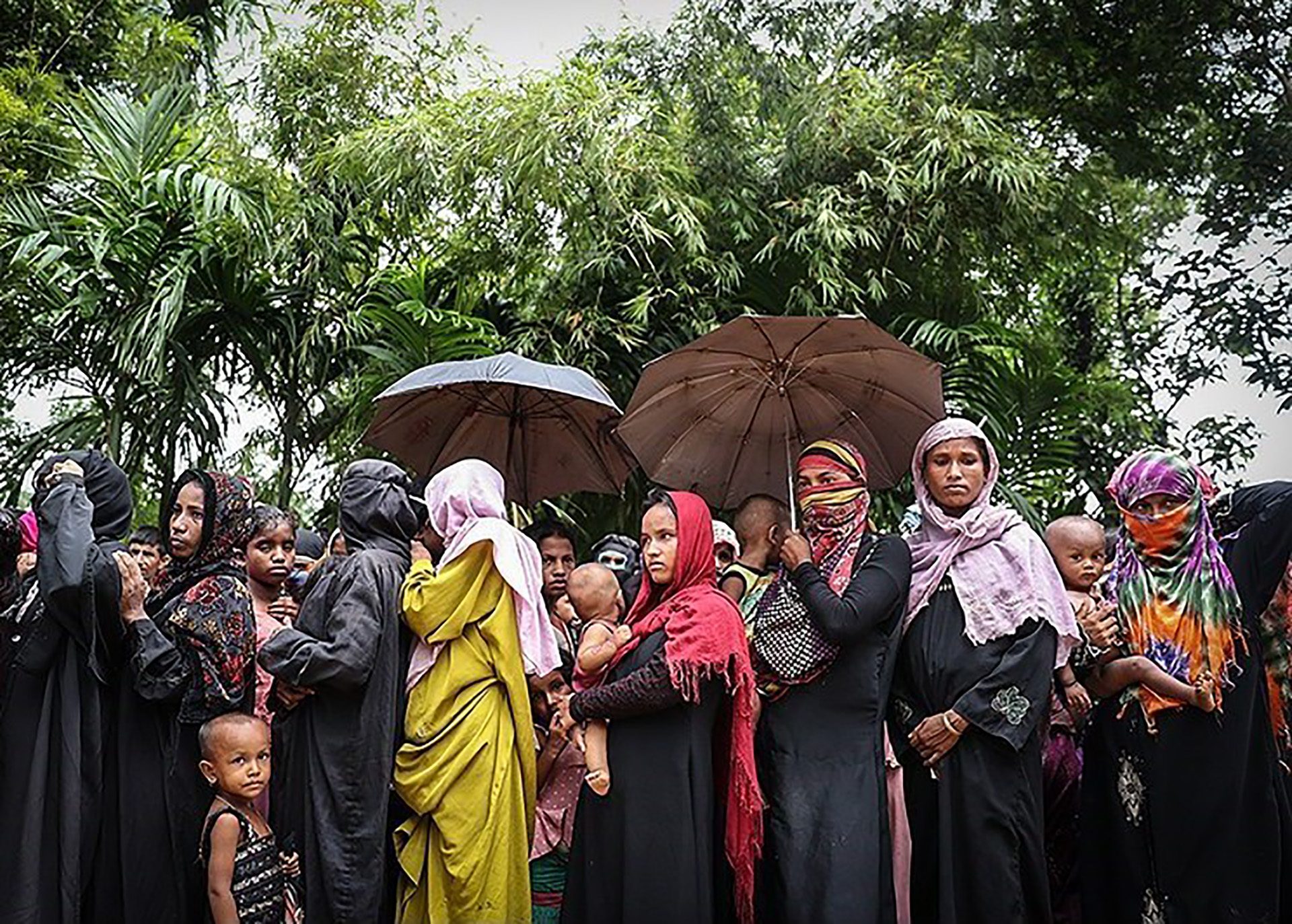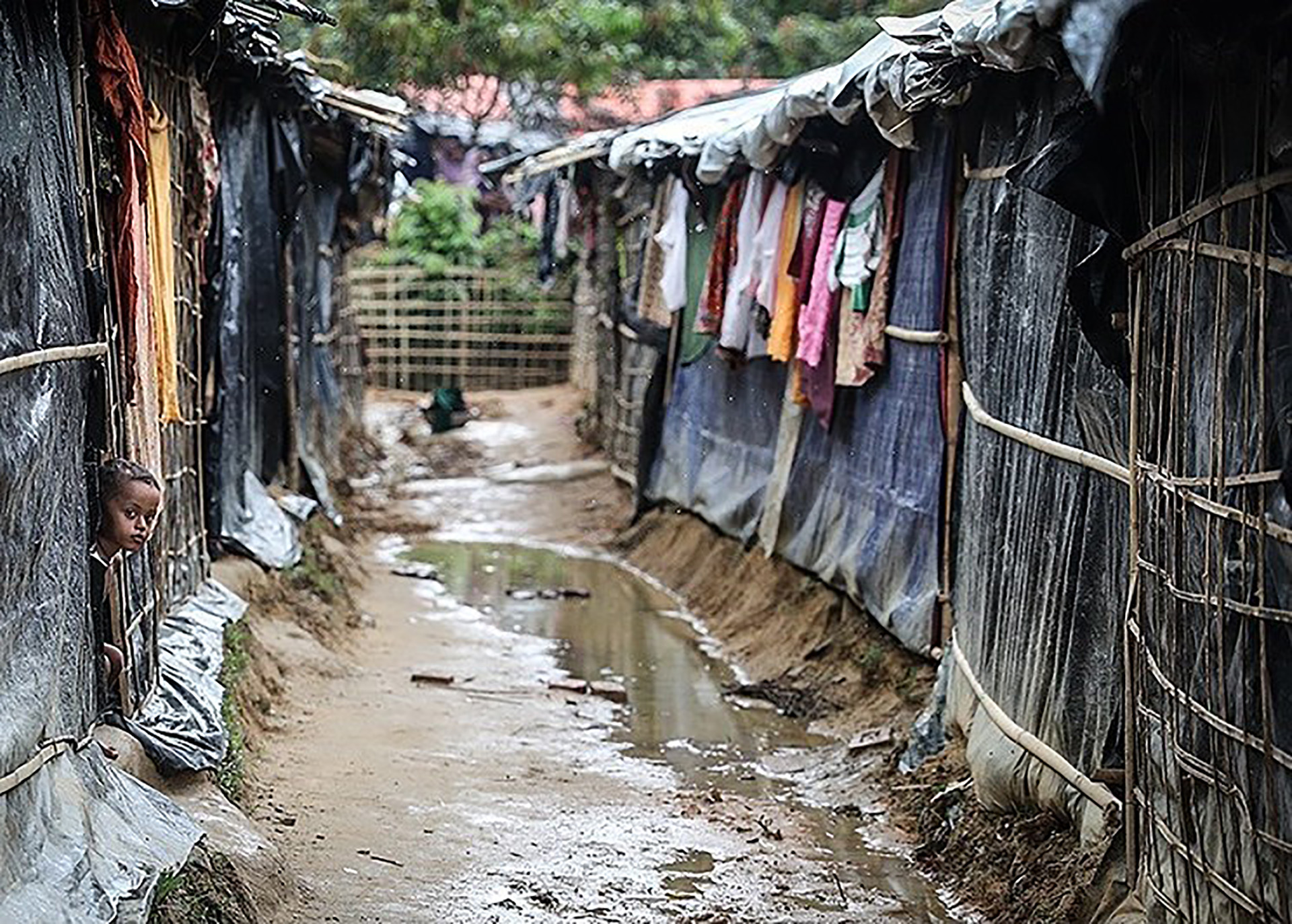
by Soleil Westendorf
This is the fourth and final installment of our four-part series about the current violence being committed against the Rohingya in Myanmar. For further insight into the violence, read the first, second, and third installments of the series. Photo: A group of displaced Rohingya women and their children, courtesy of Tasnim News Agency via Wikimedia Commons.
“I will start hoping that I can go back when there is peace and when we hear no more gunshots. Only then will I start hoping.”— Lashi Roi Ja, 30[1]
Lashi Roi Ja is one of the hundreds and thousands of Rohingya who have been internally displaced in Myanmar since alleged insurgent attacks early in 2017 instigated a nationwide military campaign to drive out the Muslim Rohingya minority from the predominately Buddhist Rakhine State. Since the beginning of the 1700s, the group has been subject to state oppression; suffered discrimination, segregation and other human rights abuses, including rape, torture and extrajudicial killings. Previous crackdowns including those in 1942, 2012, and 2015, and the government orchestrated ‘cleansing’ operations of the 70’s and 90’s such as “Operation Dragon King”[2] and “Operation Clean and Beautiful Nation,”[3] have also resulted in the internal displacement of Rohingya.
There are over 1.1 million[4] Rohingya living in Myanmar, however, the government refuses to recognize them, and instead labels them as Bengali[5]; a term used derogatorily to refer to them as illegal immigrants. As a consequence, the socio-economic rights of the Rohingya are restricted in Myanmar. Even though the state is a signatory to the International Covenant on Economic, Social and Cultural Rights, they have not ratified it. The Rohingya are unable to obtain access to secondary education and are prohibited from certain positions in the workforce. Instead many are compelled to carry out forced labor by local Peace and Development councils including work on a 230km fence along the border with Bangladesh. This project began construction in 2009 and will also prevent many Rohingya from fleeing Myanmar. The government also restricts the internal movement of the Rohingya inside Rakhine. Not only are travel plans subject to approval by the Councils[6], following the 2012 violence, the government forcibly resettled 120,000[7] internally displaced persons into closed camps where they are unable to leave and live off little access to food, and healthcare facilities. Despite international pressure to close the camps, Myanmar’s government has been unresponsive.
As if the situation could not worsen, the government has continuously reinforced plans to entrench discrimination and segregate the Rohingya community. Under the auspices of a post-conflict reconstruction plan aimed at bringing development and stability to Myanmar during its democratic transition, the 2013 Burmese Government Rakhine State Action Plan outlined the permanent resettlement of 133,023[8] Rohingya from internal camps to unstated locations around Myanmar. What seems equally remarkable is that the government seems to be convinced that this relocation (detailed under one of six sections of the plan) is compatible with a section entitled “Peaceful Co-existence.”[9] Although, when Wunna Maung Lwin, Foreign Minister of Myanmar, unveiled the plan to the General Assembly in 2014 in the hope of gaining the support of the Member States, unsurprisingly, his calls for the assistance of the UN to implement the plan were ignored. Apparently, it is difficult for some to comprehend why this “blueprint for permanent segregation and statelessness” (Phil Robertson, Deputy Direct Human Rights Watch Asia Division, 2014) cannot be reconciled with the UN’s mission to maintain international peace and security.
Flash forward to 2018. In the last few months, since August 2017, over 615,000[10] have crossed the border into neighboring Bangladesh, placing the total number of Rohingya living in the country at approximately 828,000[11]. Elsewhere, others have made the journey to host-states Thailand and Malaysia. These journeys have made the group even more vulnerable to further human rights abuses by smugglers[12], with many victims of sexual violence suffering from serious injuries that are made worse by walking after attacks. Many have given birth along the way, and others suffer the consequences of anti-personnel landmines laid by the military[13]. Many who flee suffer physical and psychological trauma, and tell stories of burned villages, sexual violence including gang rape, starvation, and killings. The situation on the ground is increasingly complicated. If however, they survive this, upon arrival Rohingya face even further discrimination, with numerous concerning reports of trafficking and sexual exploitation surfacing[14], in both official and unofficial refugee camps, not to mention the jungle camps in Thailand and Malaysia run by smugglers where mass graves were also uncovered in surrounding areas[15]. They have access to limited humanitarian assistance and continue to face challenges securing basic human rights including access to food, education, healthcare, and employment.

At the crux of the problem lies a legal void created by the host-states. Thailand, Bangladesh, and Malaysia, are not party to the 1951 Convention Relating to the Status of Refugees, nor to the 1954 Convention Relating to the Status of Stateless Persons. Both conventions are key to protecting the rights of refugees and stateless persons; they establish recognition and minimum standard of treatment for such persons including access to education and employment. Without such recognition, they come up against challenges securing basic human rights. Above all, being party to the 1951 Convention means that signatory states must observe the fundamental principle of non-refoulement, which prevents countries from repatriating and sending back refugees to countries where they may be subject to further persecution. Although Thailand, Bangladesh and Malaysia have not signed the convention, they are bound by customary international law to observe this principle. However, their track records show a clear disregard for the principle of non-refoulement.
Thailand claims it is prepared to receive more “displaced persons”[16] though has not explicitly referred to these persons as Rohingya. What remains unclear is how Thailand will be able to fully support the Rohingya, and prevent discrimination, if the government has still not changed domestic policy to provide them with legal recognition. In 2015, Thailand, Malaysia and also Indonesia further subscribed to a “help-along policy”[17] whereby refugees were supplied with little basic essentials and pushed back out to sea with the knowledge that these Rohingya may not reach a third country. Additionally, as early as 2011 Bangladesh refused a 33-million-US-dollar UN aid package[18], prompted by fears that this would incentivize a greater influx of refugees. Sadly, it seems that once again states missed the memo and continue to deflect responsibility fuelling a vicious circle of human rights abuse
So far, there has been a largely uniform front between the humanitarian and the international political community to strongly condemn the actions of the Burmese Government, and pressure Myanmar to end the “use of excessive military force” in Rakhine. These comments came as Sebastiano Cardi, President of the United Nations Security Council, also addressed the Council late in 2017, urging the government to “restore civilian administration and apply the rule of law, and to take immediate steps in accordance with [the Government’s] obligations and commitments to respect human rights”. However, a controversial and precarious proposition to implement “safe zones,” made by Bangladesh’s Prime Minister Sheikh Hasina at the General Assembly in November created divisions between both communities. Most notably, Richard Weir a fellow from the Human Rights Watch Asia Division, expressed concerns over the use of the term, cautioning that “[safe zones] rarely live up to their name” and merely cast the illusion of safety, as witnessed during the conflicts in Sri Lanka and Bosnia and Herzegovina.
Although there is a glimmer of hope with humanitarian agencies such as Medécins Sans Frontières (MSF), Save the Children, and the United Nations High Commissioner for Refugees (UNHCR) tirelessly working on the ground to provide emergency aid and relief, without the support of host-states who do not recognize the status of refugees or stateless persons in international law, it is unlikely that the situation will improve. At the grassroots level individuals also have a part to play. Individuals are encouraged to remain informed and pursue local channels of government to call upon their own politicians to speak out against the Burmese Government and military. Furthermore, individuals can engage with NGOs such as Amnesty International by signing petitions to end the sectarian violence. The Rohingya are one of the world’s most persecuted minorities. Without the legal recognition they deserve, the fate of hundreds and thousands of stateless, internally displaced persons, and refugees remains uncertain.
*Views expressed in this story reflect those of the author and not an organizational stance by PCRC.*
- [1] Jenssen, Thale. 2017. “The faces of Myanmar’s internally displaced”. Al Jazeera, 15 July 2017. http://www.aljazeera.com/indepth/features/2017/07/faces-myanmar-internally-displaced-170711090042972.html. (Accessed: 6 December 2017).
- [2] Human Rights Watch, Burma/Bangladesh: Burmese Refugees in Bangladesh II-Historical Background (2000). https://www.hrw.org/reports/2000/burma/burm005-01.htm (Accessed: 6 December 2017).
- [3] Ibid
- [4] Amnesty International. 2017. “Who are the Rohingya and why are they fleeing Myanmar?”. Amnesty International, 7 September 2017. https://www.amnesty.org/en/latest/news/2017/09/who-are-the-rohingya-and-why-are-they-fleeing-myanmar/. (Accessed: 6 December 2017).
- [5] Adam, Taylor. 2017. “How Burma’s Rohingya crisis went from bad to worse”. The Washington Post, 6 September 2017. https://www.washingtonpost.com/news/worldviews/wp/2017/09/06/how-burmas-rohingya-crisis-went-from-bad-to-worse/?utm_term=.23876cc47b7d. (Accessed: 6 December 2017).
- [6] Human Rights Watch, Burma/Bangladesh: Burmese Refugees in Bangladesh III-Discrimination in Arakan (2000)
- [7] Simon Lewis, Wa Lone. “Exclusive- U.N. criticises Myanmar plan to resettle in ‘camp-like’ villages”. Reuters, 27 April 2017. https://uk.reuters.com/article/uk-myanmar-rohingya-resettlement/exclusive-u-n-criticises-myanmar-plan-to-resettle-rohingya-in-camp-like-villages-idUKKBN17T2BF. (Accessed 6 December 2017).
- [8] Human Rights Watch. 2014. “Burma: Government Plan Would Segregate Rohingya”. Human Rights Watch, 3 October 2014. https://www.hrw.org/news/2014/10/03/burma-government-plan-would-segregate-rohingya. (Accessed: 6 December 2017).
- [9] Ibid
- [10] The Inter Sector Coordination Group (2017). Bangladesh: Cox’s Bazar refuge (4w)-as of 10 Nov 2017. Retrieved from https://www.humanitarianresponse.info/system/files/documents/files/20171110_4w_final.pdf
- [11] The Inter Sector Coordination Group (2017). Bangladesh: Cox’s Bazar Humanitarian Snapshot (as of 12 November) Retrieved from: https://www.humanitarianresponse.info/system/files/documents/files/20171112-bgd_snapshot.pdf
- [12] Syed Tashfin Chowdhury. “Meet Bangladesh’s people smugglers”. Al Jazeera. 23 June 2015. http://www.aljazeera.com/indepth/features/2015/06/meet-bangladesh-people-smugglers-150623083053794.html. (Accessed: 6 December 2017).
- [13]Landmine & Cluster Munition Monitor. 2017. “Myanmar_Burma Mine Ban Policy”. http://www.the-monitor.org/en-gb/reports/2017/myanmar_burma/mine-ban-policy.aspx. (Accessed: 6 December 2017).
- [14] International Organisation For Migration. 2017. “UN Migration Agnecy Warns of Trafficking, Labour Exploitation, Sexual Abuse of Rohingya Refugees”. http://www.iom.int/news/un-migration-agency-warns-trafficking-labour-exploitation-sexual-abuse-rohingya-refugees. (Accessed: 6 December 2017).
- [15] Beh Lih Yi and agencies in Wang Kelian. 2015. “Malaysia migrant mass graves: police reveal 139 sites, some with multiple corpses”. The Guardian, 25 May 2015. https://www.theguardian.com/world/2015/may/25/malaysia-migrant-mass-graves-police-reveal-139-sites-some-with-multiple-corpses. (Accessed: 6 December 2017).
- [16] Reuters Staff. 2017. “Thailand ‘preparing to receive’ those fleeing Myanmar violence”. Reuters, 29 August 2017. https://www.reuters.com/article/us-myanmar-rohingya-thailand/thailand-preparing-to-receive-those-fleeing-myanmar-violence-idUSKCN1B9164. (Accessed: 6 December 2017).
- [17] Human Rights Watch. 2015. “Southeast Asia: Put Rights at Center of Boat People Summit”. https://www.hrw.org/news/2015/05/27/southeast-asia-put-rights-center-boat-people-summit. (Accessed: 6 December 2017).
- [18] Deutsche Welle. “Bangladesh keeps door firmly shut on Rohingya”. DW, 17 July 2012. http://www.dw.com/en/bangladesh-keeps-door-firmly-shut-on-rohingya/a-16103069 (Accessed: 6 December 2017).


